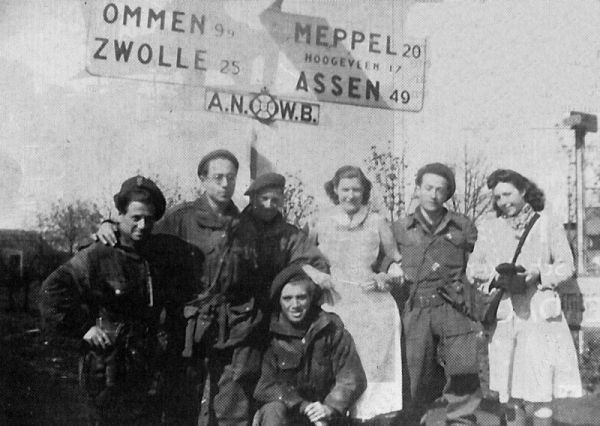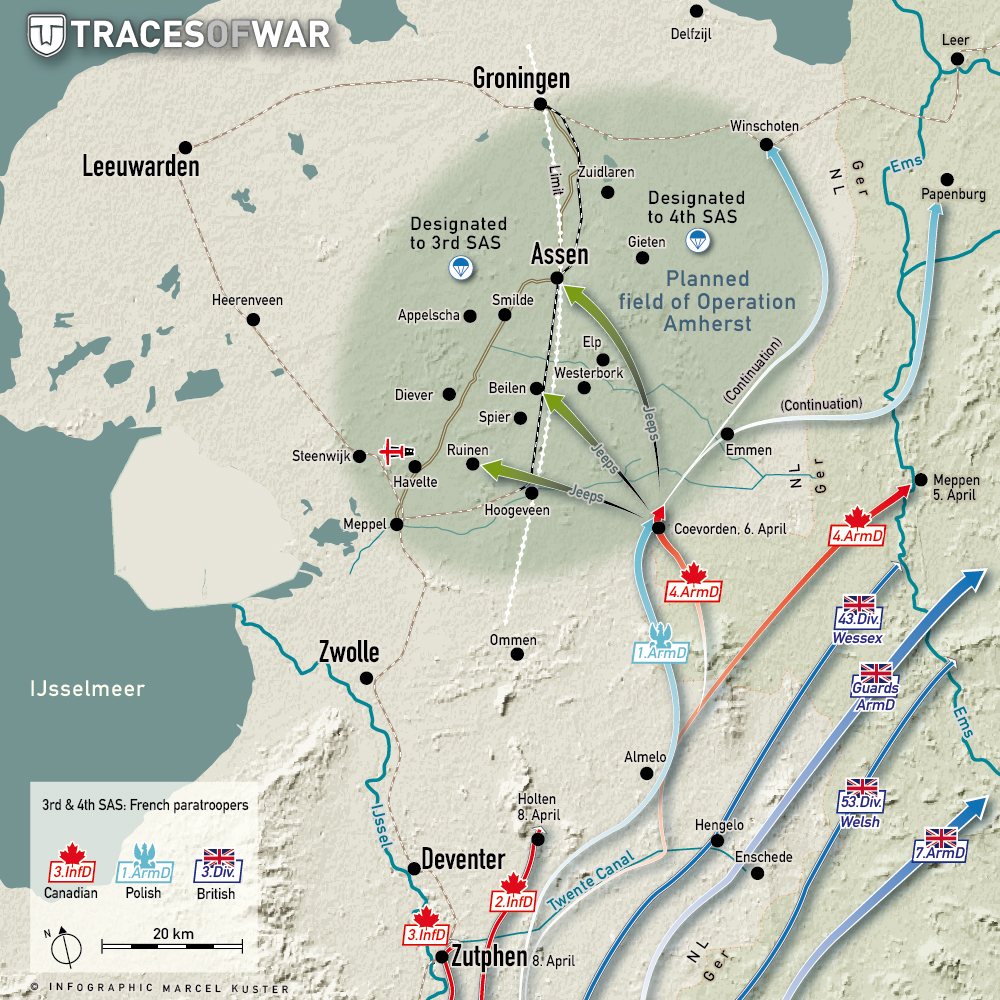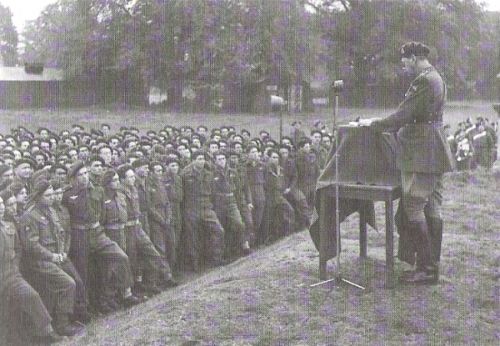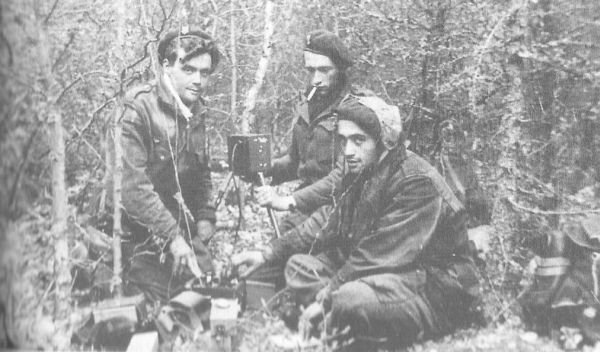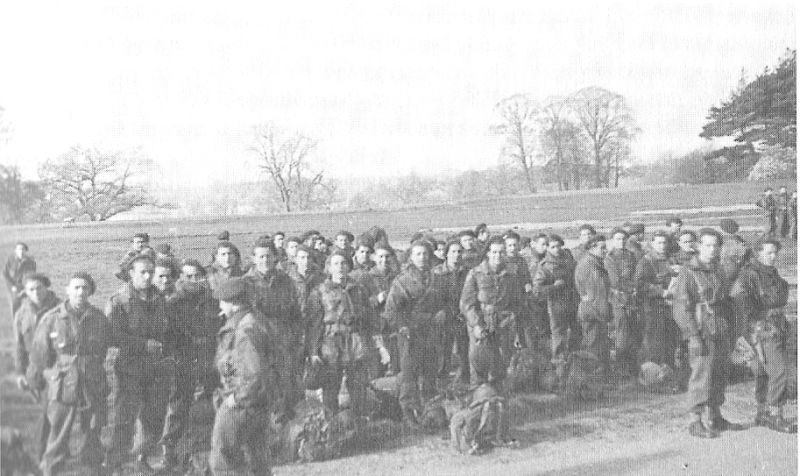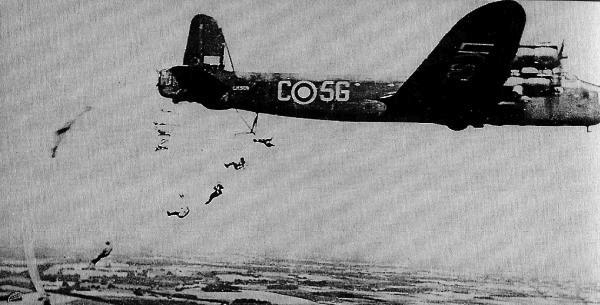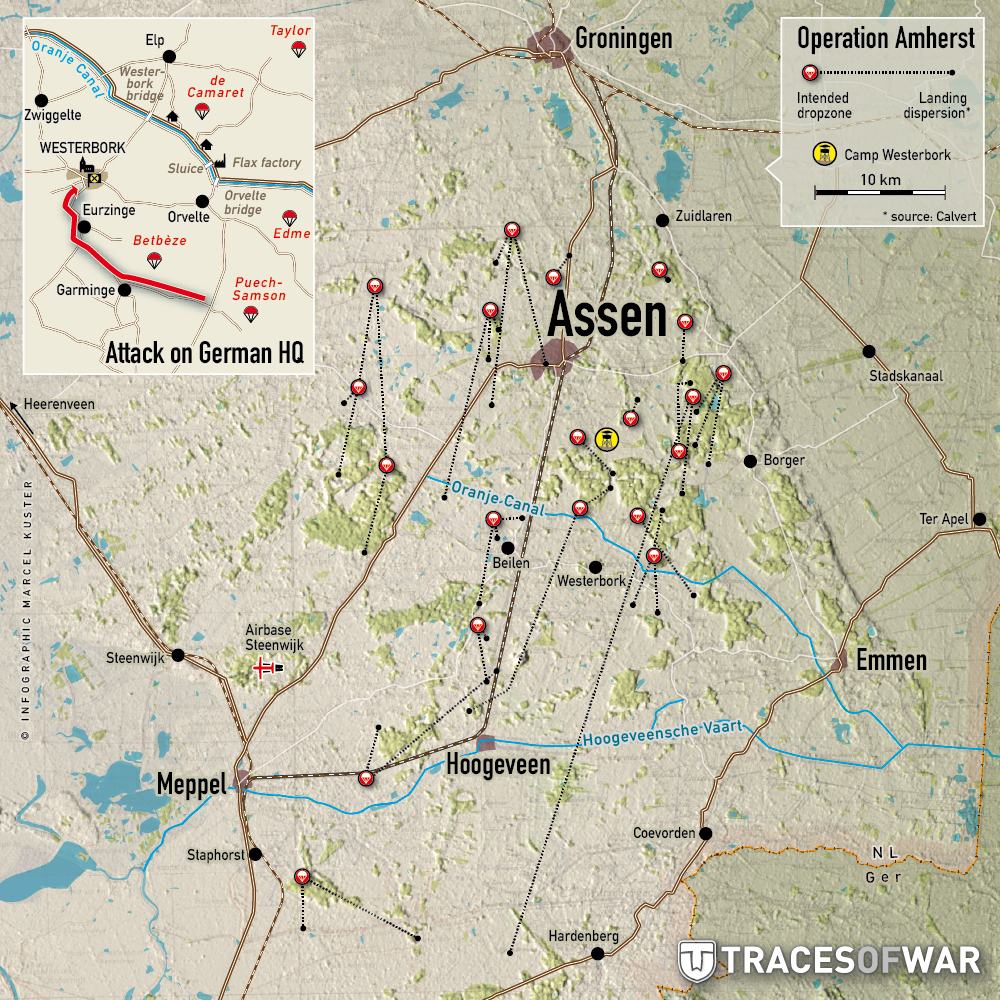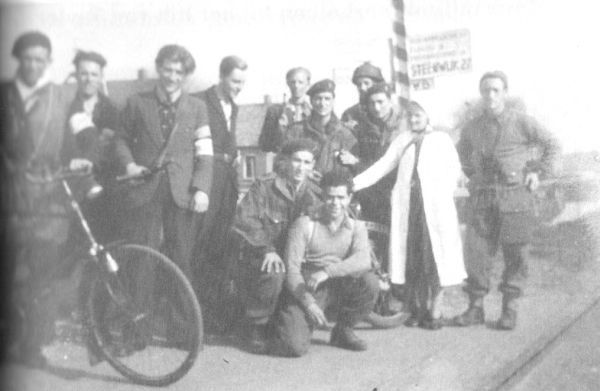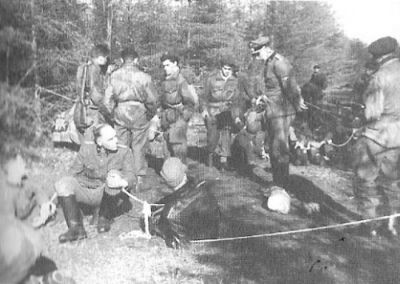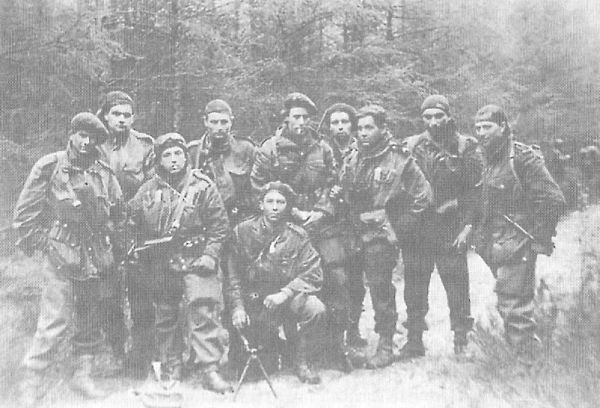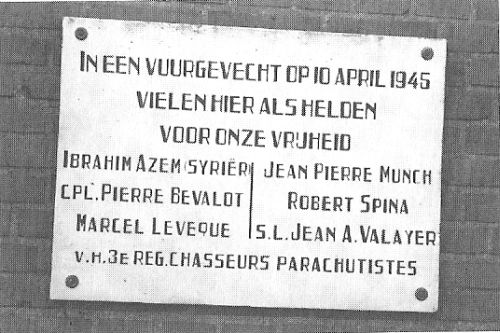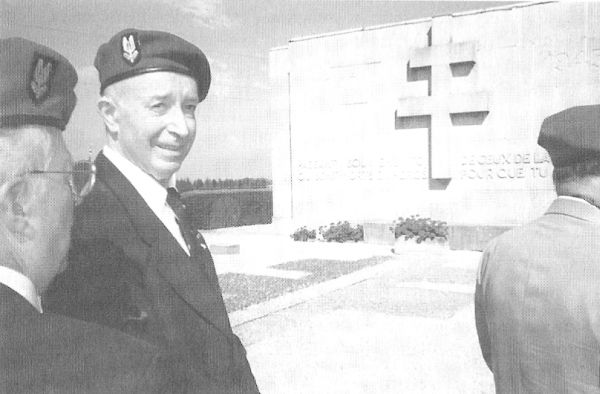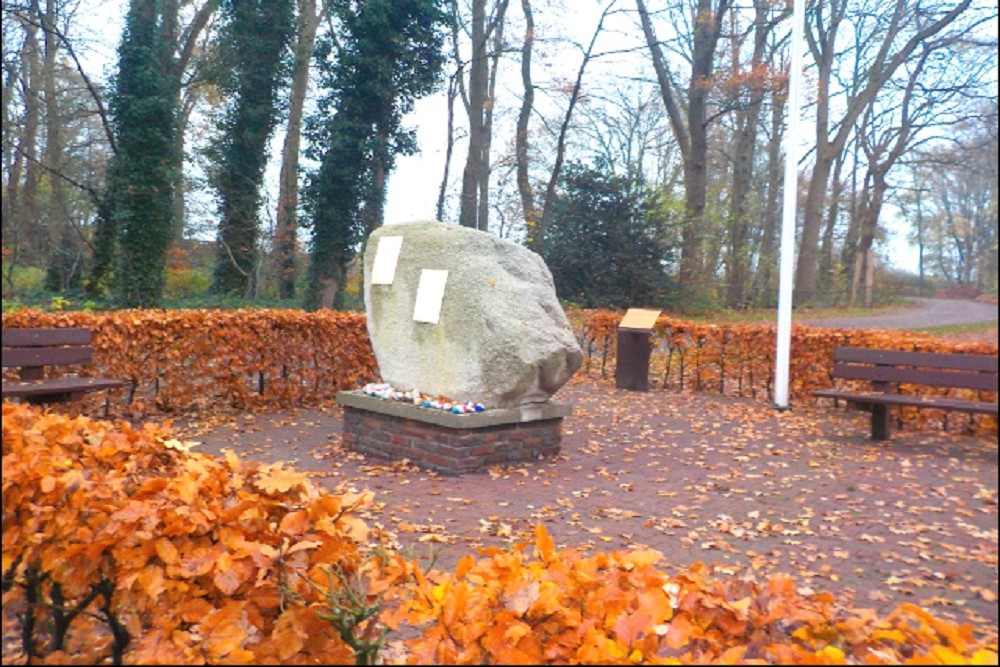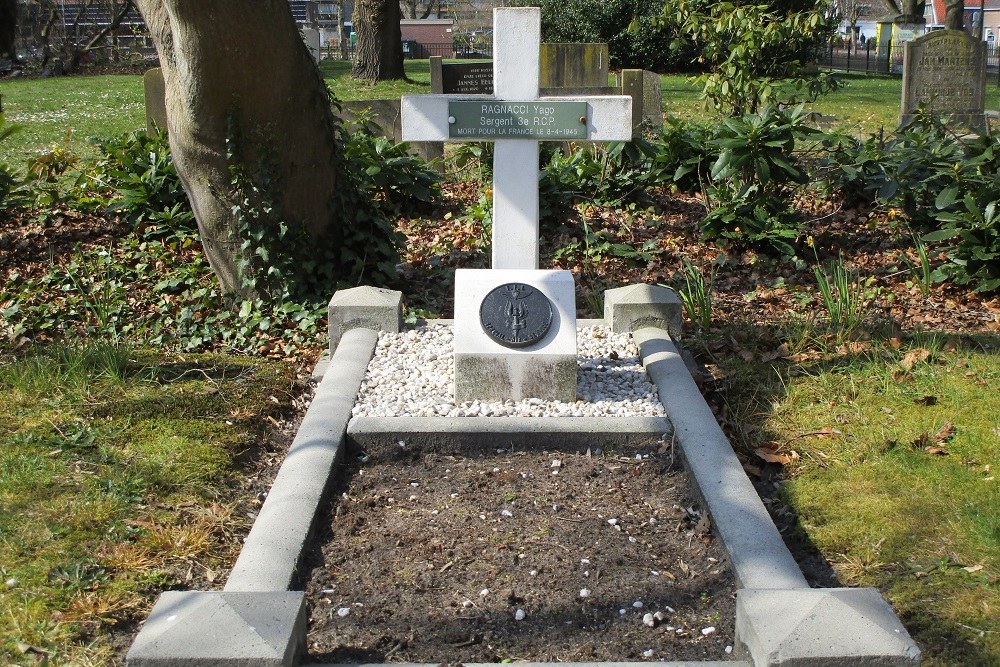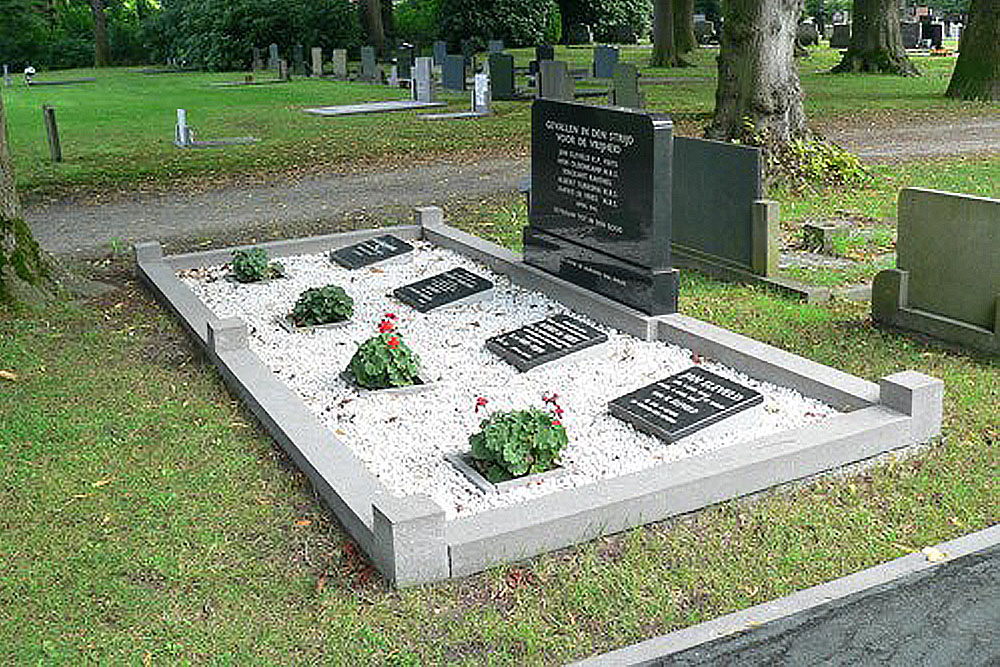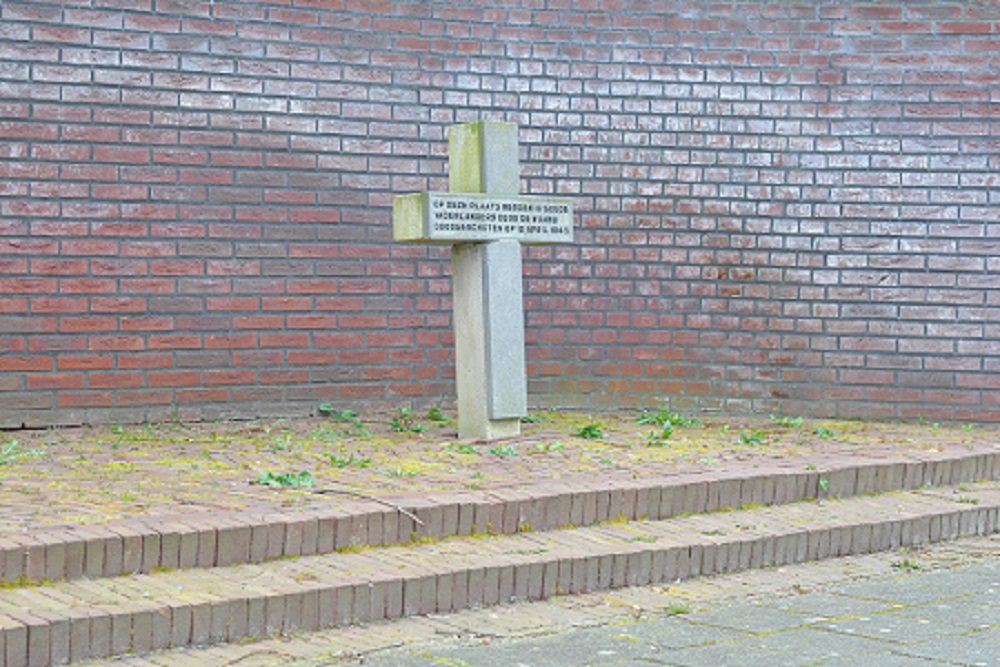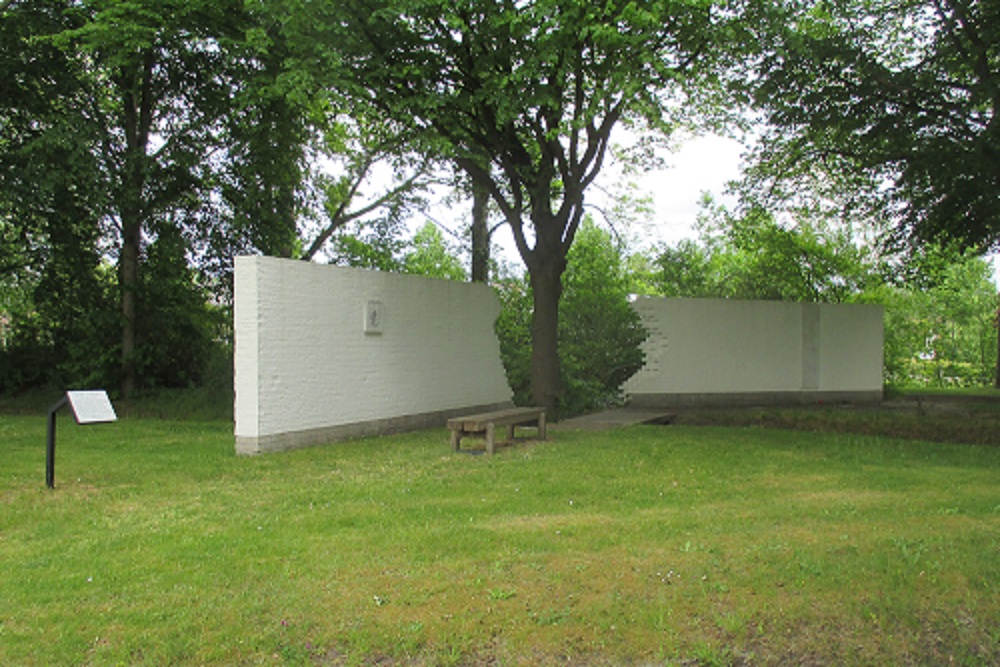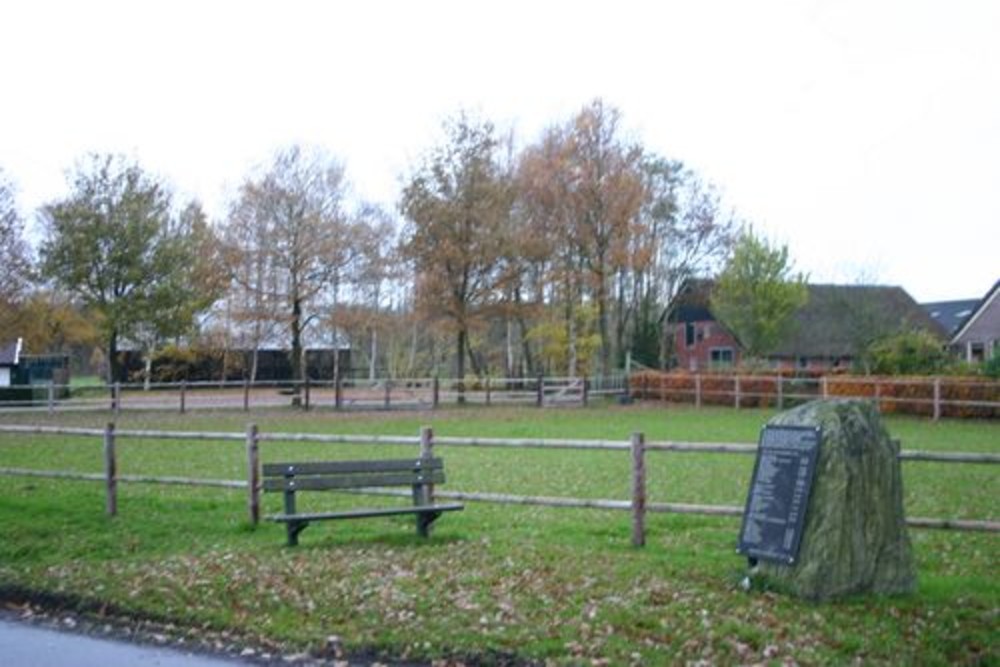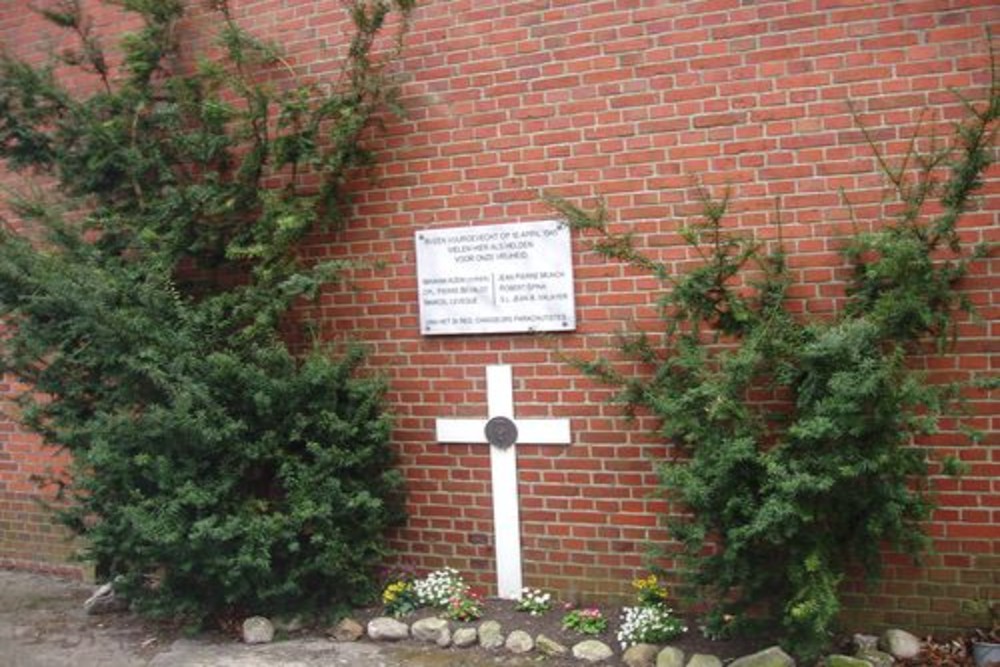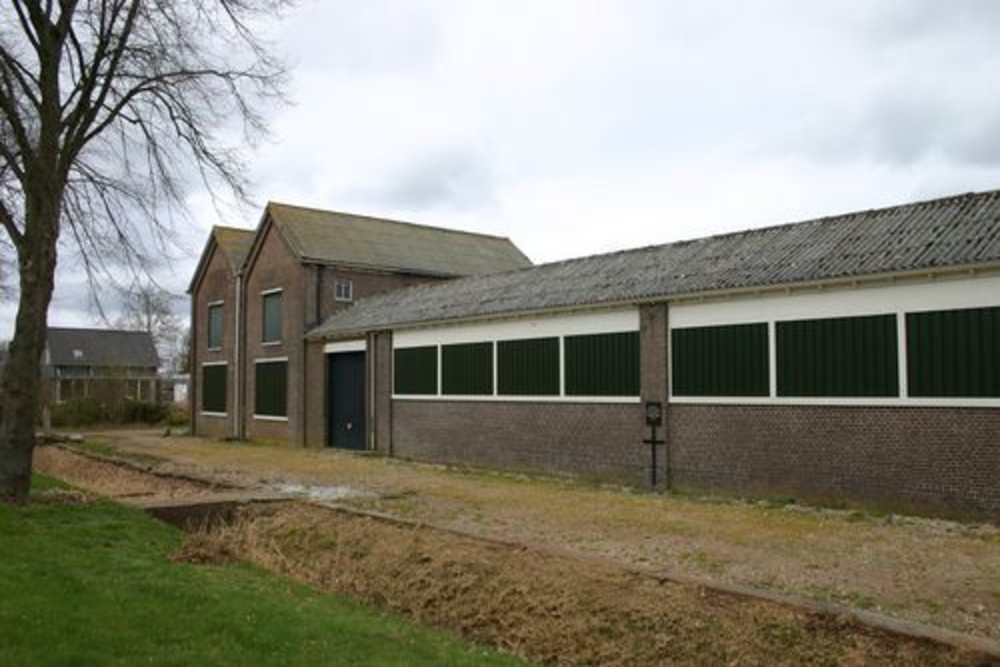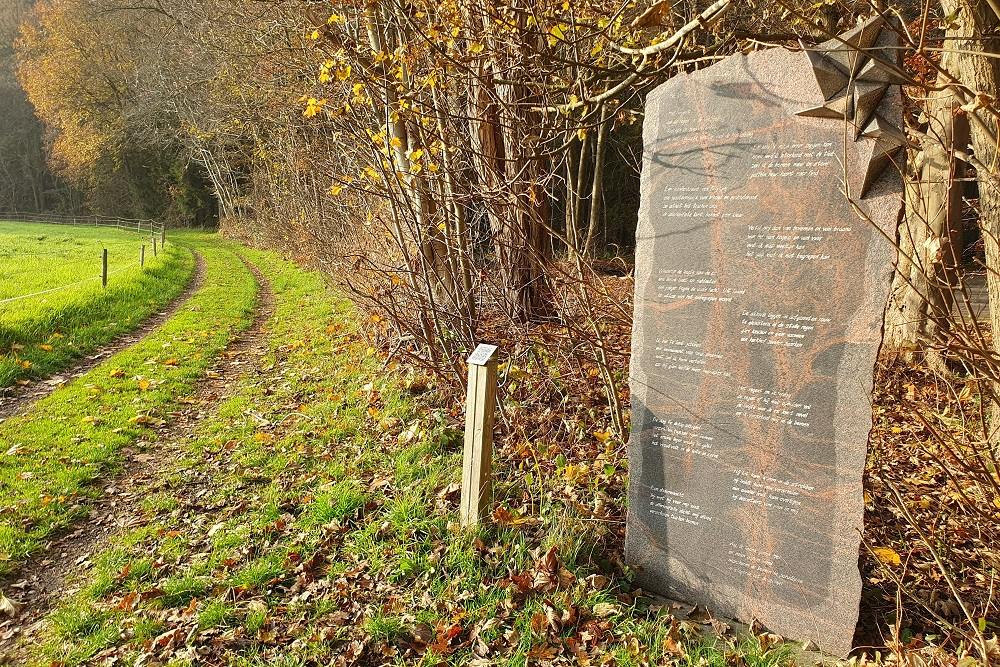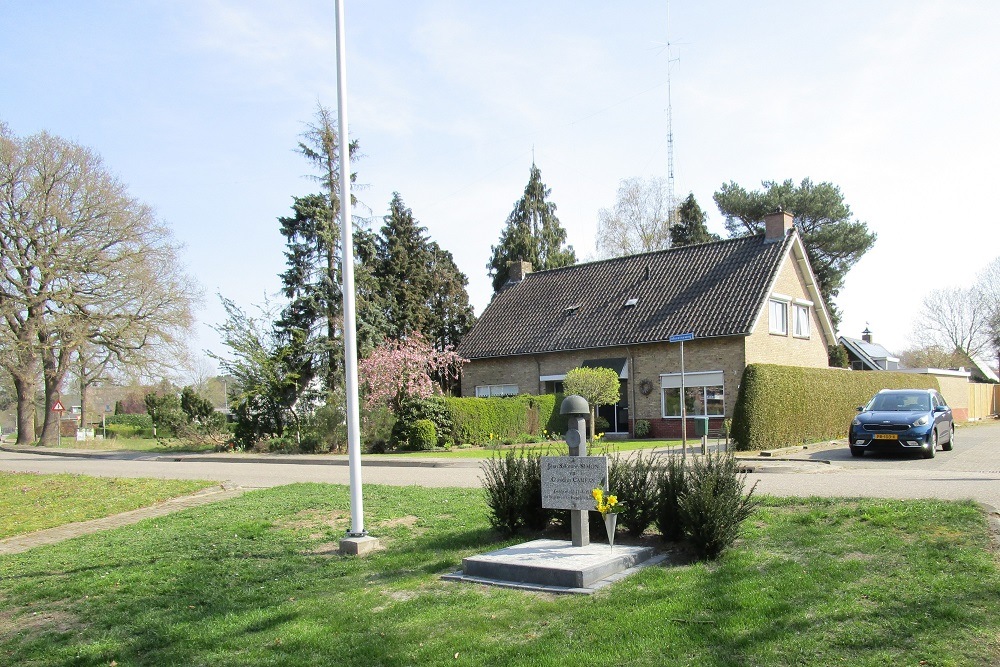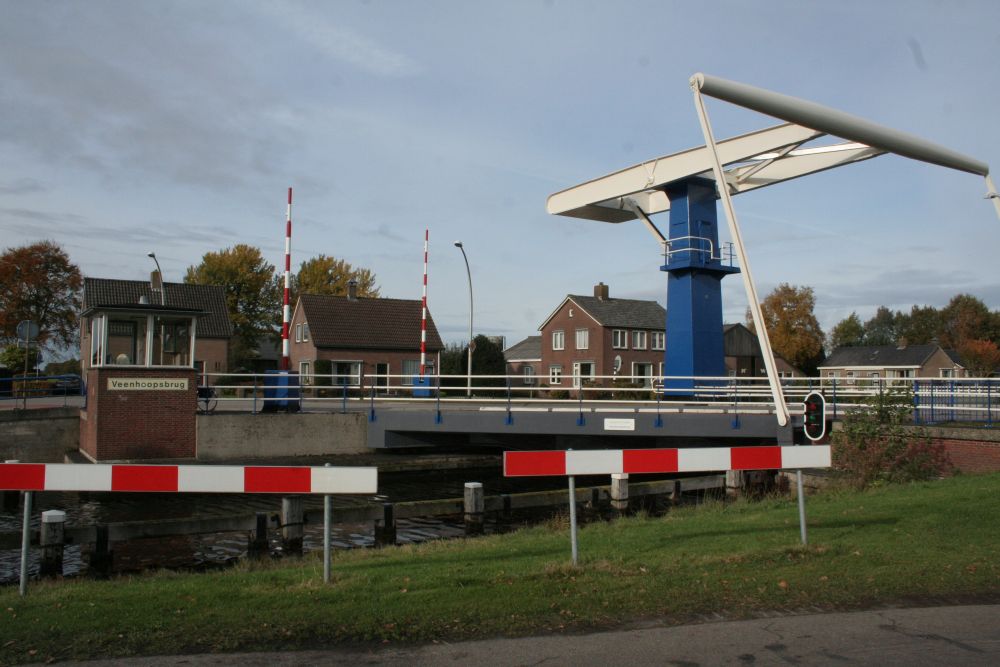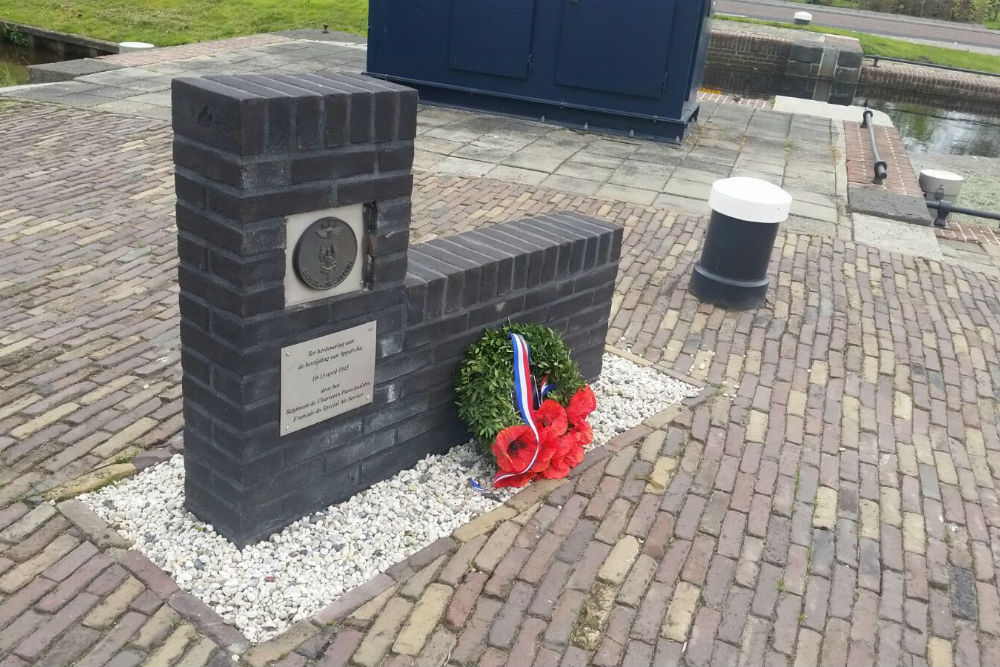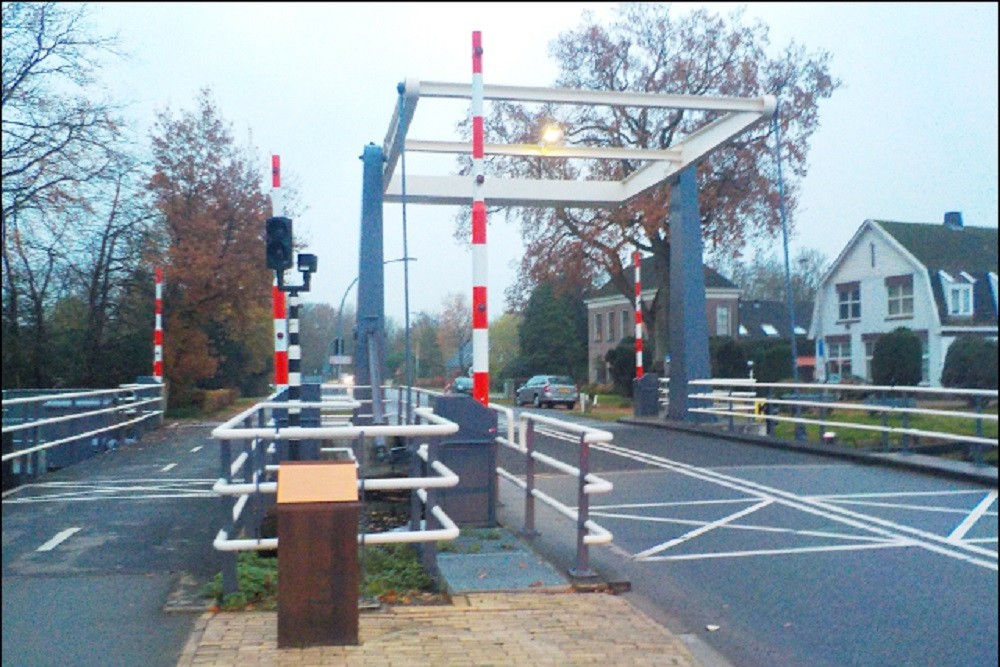Introduction
During the night of Saturday 7 to Sunday 8 April 1945 the last parachutist operation in The Netherlands started over the (eastern) province of Drenthe. The dropping of 702 French (SAS) paratroopers intended to support the further advances of the Second Canadian Army Corps.
Because Operation Amherst is unknown to many people and because there are only rather a few write ups about this modest allied operation, the author strives with this contribution to save the French paras and their fighting from oblivion. As a guidance the book Amherst, les parachutists de la France libre, 3e et 4e SAS Hollande 1945. [ Amherst, the French paratroopers of the Free French Forces, the 3rd and 4th SAS - The Netherlands 1945] edited in 1998 by the French (former) Colonel Roger Flamand, has been used which has been translated into Dutch by the author of this article, Jaap Jansen, (former) Lieutenant Colonel of the Infantry in The Netherlands.
Roger Flamand, in those days soldier-volunteer participant to “Amherst” was allowed, many years after the end of the war as a Colonel, access to some British (SAS) archives that were secret up till then. The gathered information, as well as the many battle reports of the at that time (sub) commanders, and a number of statements of eyewitnesses, all together are the most important sources for his book.
Definitielijst
- Infantry
- Foot soldiers of a given army.
- paratroopers
- Airborne Division. Military specialized in parachute landings.
Images
The operation in the larger context
As indicated above, “Amherst” was closely connected to the (further) progress of the 2nd Canadian Army Corps. This corps, together with the 1st Canadian Army Corps was part of the 1st Canadian Army under the command of Lieutenant General Henry D.G.Crerar, had orders to liberate the north of The Netherlands and to act as the western flank protection of the 2nd British Army, which operated in the west of Germany. The 2nd Canadian Army Corps consisted at the start of Operation Amherst out of three divisions: the 2nd and 3rd Canadian Infantry Division and the 1st Polish Armoured Division, which was under the command of the Polish General Major S. Maczek.
The British SAS (Special Air Service)- Brigade, which had developed slowly but surely from a company (1941) to the strength of a brigade (1944), consisted out of the following components: two British battalions (1st and 2nd Battalion), two French battalions, a Belgian battalion (‘minus’ = a battalion that is not up to full strength) and a communication unit.
The general orders of this brigade, which had an English staff, were to support the ground operations of the allied forces by carrying out commando raids. Both French battalions which originally were called Deuxième and Troisième Régiment de Chasseurs Parachutistes [2nd and 3rd Regiment Parachutists] were re-baptized in the British organization into 4th and 3rd Battalion. They carried out Operation Amherst. This code name was derived from the British Marshall (Baron) Jeffrey Amherst (1717-1797).
Definitielijst
- Brigade
- Consisted mostly of two or more regiments. Could operate independently or as part of a division. Sometimes they were part of a corps instead of a division. In theory a brigade consisted of 5,000 to 7,000 men.
- Infantry
- Foot soldiers of a given army.
- Regiment
- Part of a division. A division divided into a number of regiments. In the army traditionally the name of the major organised unit of one type of weapon.
Images
Preparations
On 21 March 1945 Brigadier Jim Mike Calvert became the commander of the SAS-Brigade. Calvert, a (32 years) young and dynamic British officer with an impressive reputation, had shortly before returned from Burma, where he had fought the Japanese with lots of success. His nickname Mad Mike (for the French in his unit ‘Mike le Fou’) was derived from that period. Calvert took over some plans which were already worked out to a large extend, from his predecessor, Brigadier R.W. McLeod, who departed in March for India. Amongst those plans were the deployment of a part of the brigade in the north of The Netherlands (Operation Amherst). On 28 March he received instructions from his commander to coordinate the possible engagement of his SAS-Brigade with the 1st Canadian Army in Nijmegen. Thus the planning for “Armherst” was further detailed and formalized into a preliminary plan which was mainly accepted and unchanged by Crerar as “Operational Order Nr 3”.
Already at his accepting of the command of the brigade Calvert had ordered to enhance the battle readiness of his unit in such a way that they would be able to get into action within a short notice. The brigade of which some smaller ”sub- units” at the strength of 186 men had participated from the north east of France in the Battle of the Bulge, were in County Suffolk in the south east of England since 19 February. During this recovery period, amongst others personal losses were replenished and training carried out. Apart from the optimizing of the operational abilities of his troops, Calvert and his staff had to arrange many other matters like coordination with the air force. In this case the 38th Group Royal Air Force for transport and the 48th Group Royal Air Force for tactical air support . All this within only one weeks’ time. Next to that the deployment of his two French battalions had to be set up in close cooperation with the 2nd Canadian Army Corps.
Also in the area of communications the necessary items had to be coordinated. It was decided to equip each of both battalions with four two-way-communication installations . This had to enable the connections with the higher echelon. The “sticks” would be equipped only with receivers in order that they could listen in and be kept up to date on the progress of the operation.
Furthermore Calvert had to take into account that, in the eastern part of his own French operational area, a number of a few dozen armored jeeps of the Belgian SAS-Battalion would be performing reconnaissance missions to gather intelligence for one of the divisions of the 2nd Canadian Army Corps. (Operation Larkswood). As a side-task this battalion, that was moving on the road from Belgium to the north of The Netherlands, had to support Operation Amherst where possible.
And last but not least, coordination with the staff of the Special Forces had to be carried out about the deploying of a so called “Jedburghteam” . (The name refers to the city of Jedburgh in south Scotland where they had been trained. Such team was usually composed of four specialists, amongst whom a radio operator, who had to cooperate with the resistance.) This Jetburghteam would consist during the operation of the Dutch Captains Bestebreurtje and Ruys-van-Dugteren and of two Englishmen: team commander Major Harcourt, and Sergeant Radio Operator Somers.
Definitielijst
- Brigade
- Consisted mostly of two or more regiments. Could operate independently or as part of a division. Sometimes they were part of a corps instead of a division. In theory a brigade consisted of 5,000 to 7,000 men.
- resistance
- Resistance against the enemy. Often also with armed resources.
Images
Assignment and misleading
In general, the instructions for the two battalions "Frenchies" were to create as much confusion as possible in the hinterland of the enemy during the Canadian advance by attacking German command posts, disrupt the communications of the enemy, set up ambushes and carry out armed attacks. Next to that the paras had to prevent the Germans as much as possible from blowing up the important bridges. Furthermore it would be essential to capture some bridges undamaged and hold them till the arrival of the Canadian troops along the planned routes of the advances. Also the small aerodrome near Steenwijk had to be occupied in order to have this available for the next operations by their own troops. Other part instructions were the stimulating of the resistance groups to take actions and supply intelligence about the enemy to the approaching Canadian troops. All this had to persist for 72 hours as it was assumed that soon thereafter the Canadians would reach the French and if necessary relieve them.
Calverts general intention was to mislead the German high command at the start of the action, by making them believe that it concerned a much larger operation than it would be in reality. For that reason the more than 700 paratroops would be dropped over a wide area, with the emphasis on the province of Drenthe. In doing so, the parachutes were not to be buried after the landing, like with other operations. They had to be left lying around which might contribute to the idea that it would concern a very extensive dropping operation. Next to that a number of dummies would be dropped which had to increase the confusion and misleading. Finally the BBC and Radio Oranje (Dutch broadcasting station from London during the war) and the press had to announce on the day of the attack, that a large scale dropping operation had taken place in the north of the Netherlands. For security reasons the Dutch resistance would only be informed half a day after the start of the operation by means of a coded radio message by Radio Oranje ("Le bateau est renversé" = the boat has turned over.)
Definitielijst
- resistance
- Resistance against the enemy. Often also with armed resources.
Composition of the French battalions
In Operation Amherst only the two French battalions of the SAS-Brigade participated. In order to gain a better insight in the personnel organization of these units, and in order to increase the sense of reality, hereafter the organization in detail up to the level of the teams follows also in French.
Each battalion which was originally called in French: “Régiment de Chasseurs Parachutistes” consisted of three (battle) companies and a staff company (“Première, Deuxième et Troisième Compagnie et Compagnie de Commandement”) All companies consisted of a changing number of groups , the so called “sticks”, for reasons of the necessary homogeneity. During Operation Amherst each stick consisted of 15 men (two officers, two warrant officers and eleven corporals and soldiers). In average each company counted six sticks. If necessary a stick could be divided into two teams (“demi-sticks”) each under the command of an officer and a warrant officer.
In spite of the fact that the SAS-Brigade counted five battalions, during battle they never acted as a battalion and almost never as a company. Characteristic for the SAS was the acting in sticks. At Operation Amherst in total 47 sticks were involved. Lieutenant Colonel Jacques Paris de Bollardière, often called Bollo by his men, commanded the Troisième RCP / 3rd Battalion. Major Pierre Puech-Samson was the commander of the Deuxième RCP / 4th Battalion. Apart from the regular army officers the French paras were usually volunteers. Many had originated from resistance groups. Others came from the so called “chantiers de jeunesse” [secret semi-military training camps for the youth in the unoccupied part of France]. Almost all of them had fled the partly occupied France during the first years of the war, sometimes in a spectacular way. Some arrived in England only after many adventurous wanderings. Others who escaped via the Pyrenees had been interned temporarily in Spain in camps. For all of them it counted that they were very motivated.
Definitielijst
- Brigade
- Consisted mostly of two or more regiments. Could operate independently or as part of a division. Sometimes they were part of a corps instead of a division. In theory a brigade consisted of 5,000 to 7,000 men.
- resistance
- Resistance against the enemy. Often also with armed resources.
Images
Some Factors of importance before the start of the operation
Because the Canadian offensive advanced faster than anticipated, General Crerar ordered Operation Amherst to start already during the night of 6 to 7 April and not to wait until the 14th of April as had been the intention originally.
Fortunately the action plan had been ready around the 3rd of April and had been distributed amongst the participating units by a forward command post which Calvert had installed with the 1st Canadian Army. On 6 April however Calvert was informed that the operation had been delayed with one day and had to start during the night of 7 to 8 April. The reason for this strongly changed ‘hour H’ had been caused by the fact that the Canadians had already captured a number of the 19 planned dropping zones, amongst others around Coevorden which had been liberated on 6 April by the Canadians being the first municipality in the province of Drenthe. One of the consequences was, that in a great hurry some new dropping zones had to be established further away to the north.
The weather forecast for the nearing operation was bad. The meteorological departments predicted unanimously a low cloud base , heavy ground fog and practically no visibility. Not particularly fit for para droppings. In spite of that it was decided to go on with the operation, with the restriction that the dropping of 18 machine-gun-armed jeeps (with 18 Halifax aircraft that would start from airport Earls Colne) was canceled. These jeeps had been planned to land in a number of dropping zones to be marked by the paras. This important decision not to drop the jeeps, had been taken in the afternoon of 7 April by Chief of Staff Guy Prendergast, without the knowledge of Calvert and to his great anger (as it appeared later on). This had an immediate influence on the fighting strength and mobility of the paratroopers. (As a partly compensation a few days later ten jeeps were made available as yet to the French paras in the operational theatre via Coevorden by the British majors Neilson and Wallis.)
The most influential factor however was the expected battle force of the enemy. The strength of the available troops of the Germans in the north-east of the Netherlands had been estimated by the allied intelligence units to be a division (amongst whom a Dutch SS-Brigade) supported by a few local units (Feldgendarmerie, NSKK and various spread out units of a large paratroopers unit). Because it had been assumed that the German troops most likely would be worn out and demoralized, it had been expected that they incidentally probably would be prepared to surrender honorably when the opportunity would rise. In practice this would be proven wrong.
Definitielijst
- Brigade
- Consisted mostly of two or more regiments. Could operate independently or as part of a division. Sometimes they were part of a corps instead of a division. In theory a brigade consisted of 5,000 to 7,000 men.
- offensive
- Attack on a smaller or larger scale.
- paratroopers
- Airborne Division. Military specialized in parachute landings.
Images
Execution of the operation
On Saturday the 7th of April around 21:00, 46 four engined bomber aircraft took off from three secret military airfields in the south east of England. This started Operation Amherst in earnest. One aircraft ran into technical trouble and took off one night later as number 47. All aircraft, of the type "Short Stirling" had been "scraped together" with difficulties and departed from the following airfields: Dunmow (16), Shepherdsgrove (16) and Rivenhall (15). The logbooks of the flight crews varied between many and few flying hours in wartime.
The skill of the paras was comparable. On the one side there were a number of old war hands with a lot of battle experience gathered in the countries of North Africa, or at smaller operations in France (like "Dickens", "Derry", "Jockworth", "Moses", Abel", "Harrods" , "Sam West" etc. etc.). On the other side there were many for whom Operation Amherst was their second or third mission. And lastly there were a number of young rookies with very few or even no jumping or battle experience.
During the flight the Stirlings followed the procedures and used their board weapons over the sea. Because of the allied air superiority the chances for an interception by the enemy were limited. Between 23:45 and 01:30 the aircraft dropped their sticks over the 19 defined dropping zones. Including the four men strong Jedburgh team which had to carry out special orders, a total of 702 men. The Troisième RCP / 3rd SAS landed west of the railroad line Groningen-Assen-Hoogeveen (and in the extension thereof in southerly direction) and the Deuxième RCP / 4th SAS, east of the railroad. After a few hours all aircraft returned safely on their bases.
During their "largage" [dropping], the circumstances for the paras were unfavorable as had been foreseen. The following factors were to be blamed for that: the visibility, the jumping level and the radar operation. All that had been predicted, turned out to be reality: over the operational theatre there was a low cloud base which caused the paras not to jump from their usual level of 250 m. [approx. 820ft] but were dropped from 600 m. [approx. 2000ft], over thick clouds. Therefore they were suspended in the air for a longer period of time and the sticks were spread over a larger area because of the wind speed of 25 km/h. [approx. 15 M/hr.] and landed hard.
Apart from that there was heavy fog which made it difficult for the men to retrieve each other quickly. By far, most of the sticks succeeded nevertheless to regroup within the hour; some others did not achieve that. They lost some hours before being complete again; four sticks even never were completely back together.
In spite of these unfortunate circumstances the number of accidents was limited: Two men drowned, one was hit in the air by a container, which prevented his chute from deploying and nine others broke their bones, or got eye wounds by "falling through a tree". For the correct operation of the radar systems of the British airplanes on the one side and the coordination with the Canadian radar vehicles on the other side, it was required that these vehicles were stopped during the dropping of the parachutists.
Because this condition could not always be met, the assessment of the exact dropping point was rather imprecise in some cases, so a number of sticks did not land in the planned landing zones. Of the 46 groups 17 landed within the planned areas, 16 within a reasonable distance (5 to 8 km), while 12 sticks landed on a greater distance (8 to 15 km). One stick landed in a liberated area. In a number of cases the paras appeared to have "fallen off the map" and had to contact farmers during the night to try to find the road in order to orientate themselves. Thanks to the presence in every stick of an "Alsacien" (a French soldier who came from the Alsace and who spoke also German) this usually did not create any language problems although the population of the provinces of Drenthe and Friesland usually was stupefied to be addressed in German by men in an unknown uniform.
Next to the sticks 219 containers with weapons, ammunition and rations were dropped including 30 each for the resistance. Also as a distraction 150 dummies were dropped (called "mannequins" = puppets, by the French). These were small chutes with boxes attached that imitated gunfire and which were activated with a delaying system. The enemy were to believe that fighting was going on at these spots and to send troops unnecessarily to that area.
The fighting developed quickly after the landings in the province of Drenthe and a part of south east Friesland. Some sticks were unfortunately landing on a German convoy, after which their regrouping became rather impossible. Other sticks successfully set up ambushes, mainly in the northern woods of Drenthe. And of course the paratroopers started commando actions often successful, others less fortunate.
For example, the Commander of the 4th Battalion, Major Puech-Samson landed together with his battalion staff in a forested area near Witteveen, 7km southeast of Westerbork. He decided to instruct two sticks, that had landed close by, to attack the German command post in that village. Upon indications of the resistance and with the cooperation of the secret agent Willem van der Veer, that took place on Sunday 8 April around 13:30. The command post was put (temporarily) out of action. A number of German officers and troops were killed. The commander General Major Karl Böttger got seriously wounded. The French lost three men during this attack.
More northerly (in Gasselte) four sticks attacked successfully the NSKK command post (NSKK = Nationalsozialistisches Kraftfahrer Korps, which was a transport unit of the German Army often manned with Dutch volunteers). Here 18 Germans, amongst whom two officers, were captured and transmitted to the surrounding woods, and some got wounded. A French para lost his life. In the evening the Germans returned from Borger to Gasselte and locked the whole of the male population inside the church, this because of suspected help to the French troops. The occupying forces consequently started preparations to shoot all hostages. Fortunately this "almost drama" ended well. Sixteen civilians were imprisoned in Assen and liberated by the Canadians on 13 April.
The applied Jetburgh team, landing at Hooghalen, was unfortunate to soon lose two men. Major Harcourt was made prisoner (and liberated on 30 April from the POW camp Wesermünde) and Captain Bestebreurtje broke his ankle at the landing. Captain Ruysch-van-Duchteren however made contact with the resistance. He succeeded through his Radio-Operator Sergeant Somers to generate a weapon drop in the area.
In Smilde a stick succeeded to capture the Veenhoopsbrug [bridge] across the Drentse Hoofdvaart [= main channel] undamaged, which was important for the Canadians. This, after members of the local resistance, in this case father and son Voortman, succeeded up to two times to remove the demolition charges under the bridge. It meant that the Canadians could advance quickly northwards. Also the Stokersverlaatbrug [bridge] in Appelscha across the Opsterlandse Compagnonsvaart [= a canal] remained undamaged in the hands of some sticks which had landed by accident in that area.
In a number of locations in south eastern Drenthe the French parachutists received support from the Belgian armored jeeps and their wounded were brought back behind their own lines with these jeeps. A Polish reconnaissance unit, especially composed to rescue a number of French paratroopers from their perilous positions, was supporting the French successfully, amongst others in Westerbork.
The small airfield Steenwijk (at Havelte) which had to be captured undamaged was reconnoitered by a stick. It appeared to be useless. Some large craters indicated that it had been bombed recently by the USAAF.
On various places other German installations were attacked like in Orvelte (the flax works and the bridge) and Oranje ( the potato flour factory). In two perilous situations the paras asked for air support and re-provisioning. These were successfully provided by Typhoons of the 84th Group RAF.
In other areas however, like some kilometers northwest of Assen, some sticks suffered heavy losses in the open terrain and near a large garrison, some up to 50% of their total strength counting 11 deaths and 19 prisoners of whom 12 wounded. It concerned sticks 1,3,5 and 7 of the 1st Company of the 3rd Battalion. During one of their actions a group was betrayed by two Dutchmen which cost six paras their lives in and near a barn in Zeijerveld.
In a number of other occasions the resistance was supportive which led sometimes to reprisals. The Germans executed by summary conviction in total 33 persons as retaliation on the basis of suspected collaboration with the French paras: 21 in Spier at the Wijsterseweg (municipality of Hoogeveen), ten in Diever and two in Schoonoord. At Westerbork a 34th Dutch victim fell, a farmer on his way home was deadly wounded by a nervous German sentry.
The losses on the French side totaled 34 men (5 officers, 7 warrant officers and 21 corporals/soldiers). 32 of them were killed in Drenthe and 1 in Friesland (Haulerwijk). In total the Germans executed 7 paras and during the landing two drowned, both in the immediate vicinity of Assen. Next to that the parachutists counted 60 seriously wounded (including those that suffered from broken bones) and 69 were carried off to POW camp Wesermünde. They were liberated on 30 April by the British units.
According to allied sources a little less than 300 men were killed on the German side. Several dozen were wounded and 187 were taken prisoner. Of those, only in Friesland 47 men in the immediate environment of Appelscha. In total some thirty German vehicles were eliminated.
Definitielijst
- collaboration
- Cooperation of the people with the occupying forces, more generally spoken the term for individuals who cooperate with the occupying force is collaborator.
- paratroopers
- Airborne Division. Military specialized in parachute landings.
- POW
- Prisoner of War.
- radar
- English abbreviation meaning: Radio Detection And Ranging. System to detect the presence, distance, speed and direction of an object, such as ships and airplanes, using electromagnetic waves.
- RAF
- Royal Air Force. British air force
- resistance
- Resistance against the enemy. Often also with armed resources.
Images
Aftermath
In general it may be stated that the French paratroopers have carried out a large number of smaller battle actions in an area which provided little cover, occupied by the Germans. In many cases the actions lasted longer than the planned 72 hours. Especially those that landed in the northern part of the province of Drenthe had to continue fighting for five or six days before being released by Canadian troops. Faithful to their motto "Qui ose gagne" [Who dares wins] their performance was often very courageous, sometimes audacious and usually based on an excellent attitude. In the book of Flamand many examples may be found which often are confirmed by eyewitnesses.
Where most allied forces towards the end of the war were inclined to rely on risk avoiding behavior, this counted much less for the two French SAS-battalions. Obviously they wanted to prove themselves again, demonstrating the reason of existence of this type of specialist units, a subject which was being discussed already for a long time amongst the allied forces.
After the war, the appreciation of the allied units was great. Correctly so. This was also true for the two French Battalions. On May 9th, 1950, Queen Juliana of the Netherlands awarded the Bronzen Leeuw [Bronze Lion] to both French SAS-regiments out of recognition and ordered this medal to be attached to the standards of both regiments. On May 16 of the same year a monument in memory of all French soldiers killed in action in the Netherlands between 1940 and 1945 was unveiled in Kapelle-Biezelinge (in the province of Zeeland) on the French war cemetery. And in 1985 in Assen at the Vaart ZZ the large French parachutist monument was erected which is amongst others adorned with the text "Du ciel la liberté" [Freedom from the air]. Elsewhere in Drenthe there are eight more smaller monuments which depict an everlasting memory of Operation Amherst.
After the war there was ample opportunity to put all allied operations under the magnifying glass and to learn from the experiences. Also Operation Amherst did justifiably not escape from that. But judging with hindsight is easy, which has to be well realized. The opinions about the successes of the French paras in Drenthe differ a lot from each other. Crerar and his sub commanders for example were of the opinion that the deployment of the two SAS-battalions had contributed a lot to their own quick advancing. Others, on the contrary, state that the Germans were anyway defeated already and that the French operation had hardly accelerated the liberation of the north of the Netherlands. This would have happened anyway, but maybe somewhat later…
However, for the French SAS in the north of the Netherlands such considerations did not count. One did simply what was expected from them and that required fighting till the end. Maybe in accordance with the British saying: "Theirs not to reason why, Theirs but to do and die."
It has been confirmed in any case, that the French paratroopers earn the Dutch everlasting gratefulness and appreciation. Charles de Gaulle, THE example for these parachutist units, praised and thanked "his" Forces Franҫaises Libres amongst others with the following words: "Eux regardent le ciel sans pâlir et la terre sans rougir" [ They look at the sky without going pale and look at the ground without shame].
Definitielijst
- paratroopers
- Airborne Division. Military specialized in parachute landings.
Images
Information
- Translated by:
- Fred Bolle
- Published on:
- 03-08-2012
- Last edit on:
- 30-09-2024
- Feedback?
- Send it!
